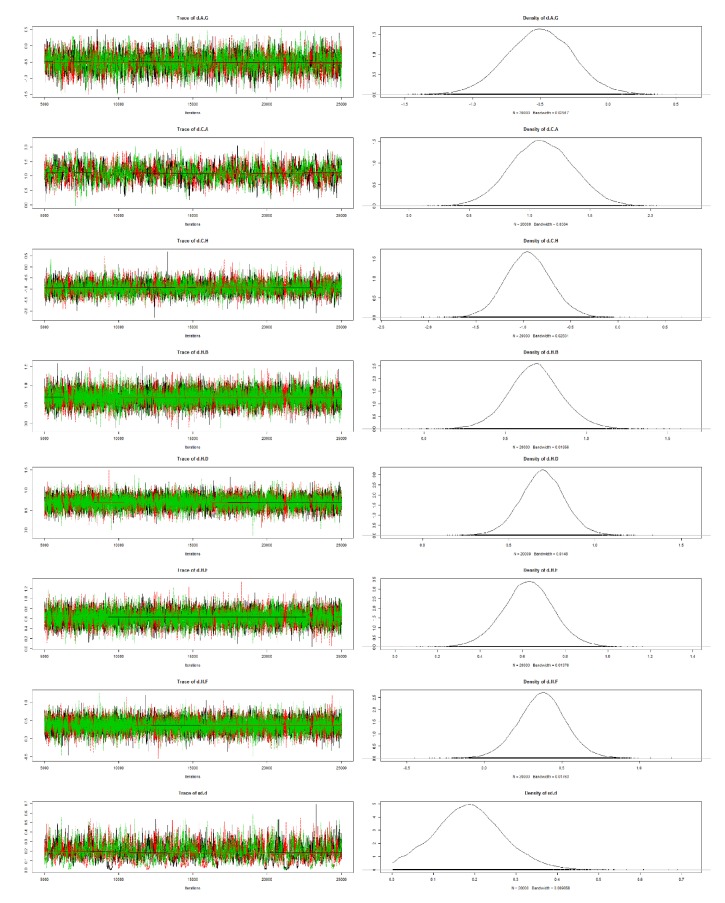Abstract
Background
The objective of this study was to compare the efficacy and side effects of acupuncture, sham acupuncture, and drugs in the treatment of diarrhoea-predominant irritable bowel syndrome.
Methods
Randomized controlled trials (RCTs) assessing the effects of acupuncture and drugs were comprehensively retrieved from electronic databases (such as PubMed, Cochrane Library, Embase, CNKI, Wanfang Database, VIP Database, and CBM) up to December 2017. Additional references were obtained from review articles. With document quality evaluations and data extraction, Network Meta-Analysis was performed using a random-effects model under a frequentist framework.
Results
A total of 29 studies (n = 9369) were included; 19 were high-quality studies, and 10 were low-quality studies. NMA showed the following: (1) the ranking of treatments in terms of efficacy in diarrhoea-predominant irritable bowel syndrome is acupuncture, sham acupuncture, pinaverium bromide, alosetron = eluxadoline, ramosetron, and rifaximin; (2) the ranking of treatments in terms of severity of side effects in diarrhoea-predominant irritable bowel syndrome is rifaximin, alosetron, ramosetron = pinaverium bromide, sham acupuncture, and acupuncture; and (3) the treatment of diarrhoea-predominant irritable bowel syndrome includes common acupoints such as ST25, ST36, ST37, SP6, GV20, and EX-HN3.
Conclusion
Acupuncture may improve diarrhoea-predominant irritable bowel syndrome better than drugs and has the fewest side effects. Sham acupuncture may have curative effect except for placebo effect. In the future, it is necessary to perform highly qualified research to prove this result. Pinaverium bromide also has good curative effects with fewer side effects than other drugs.
1. Introduction
Irritable bowel syndrome (IBS) is a disease with a high incidence rate, and diarrhoea-predominant irritable bowel syndrome (IBS-D) is a subtype of irritable bowel syndrome with a major clinical manifestation. IBS has a prevalence ranging from 1.1 to 29.2% in the whole population according to the Rome III criteria, with the diarrhoea-predominant type accounting for about 23.4% [1, 2]. Diarrhoea-predominant irritable bowel syndrome (IBS-D) leads to a great deal of trouble [3]. However, the pathogenesis of diarrhoea-predominant irritable bowel syndrome is not yet clear, and its aetiology is complex and may be caused by a variety of factors including visceral allergies, inflammatory responses, heredity, gastrointestinal motility disorders, intestinal infections, and psychosocial factors. In addition, there is a lack of morphological or biochemical abnormalities and other available organic diseases to explain the clinical symptoms [4, 5]. The current treatment methods for IBS-D include drugs and acupuncture treatment; common drugs include pinaverium bromide, eluxadoline, alosetron, ramosetron, rifaximin, and intestinal probiotics. Currently, increasing studies have shown that acupuncture may have some effect on IBS-D, but there are no efficacy comparisons between acupuncture and commonly used oral drugs, and each patient uses different acupuncture points, so we were interested in conducting a systematic review to resolve these two problems.
Now, more and more studies use sham acupuncture as the control of acupuncture. However, there is a debate on whether sham acupuncture has curative effect and to what extent sham acupuncture does affect the final result; this question could be solved with the Network Meta-Analysis.
In this study, by collecting previously published treatments of IBS-D in randomized controlled treatment studies using acupuncture and oral common drugs, we expected to determine the following issues: (1) a ranking of acupuncture and drugs in the treatment of diarrhoea-predominant irritable bowel syndrome; (2) a ranking of acupuncture and drugs in their side effects on diarrhoea-predominant irritable bowel syndrome; (3) the extent to which sham acupuncture does effect the final result; (4) the acupoint distributions used to treat diarrhoea-predominant irritable bowel syndrome.
2. Materials and Method
We conducted a standardized report based on the preferred reporting items of the PRISMA statement [6, 7].
2.1. Research Methods
We searched PubMed, the Cochrane Library, Embase, and 4 Chinese databases [China National Knowledge Infrastructure (CNKI), Wanfang Database, VIP Database, and Chinese Biomedical Database (CBM)] to conduct a comprehensive database retrieval using a (acupuncture or electro-acupuncture Or acupuncture, Sham Acupuncture, pinaverium bromide, alosetron, eluxadoline, ramosetron, rifaximin), (randomized controlled trials or randomized controlled trials or clinical trials), and (IBS-D) strategy (the retrieval time was from the building of database to 17th October, 2017). In addition, the same search was conducted for the reference reviews and meta-analyses cited in manual searches, with no language restrictions set (searching strategy in Supplementary 1).
2.2. Inclusion and Exclusion Criteria
We included randomized controlled trials that met the following eligibility criteria: (i) adult patients; (ii) single drug use; (iii) clinical trials with treatment duration greater than two weeks; (iv) articles that were not comments or commentary; and (v) patients that did not suffer from pregnancy or lactation, peptic ulcer, rectal disease, or liver or other systemic disease and had no previous history of gastroduodenal surgery or brain disease or surgery.
2.3. Research Options
Articles were independently screened by two researchers. Initially, NoteExpress software (Beijing Aegean Sea Music Technology Co., Ltd.) was used to delete duplicate records. The remaining summaries and full texts were reviewed on the basis of inclusion and exclusion criteria, and disagreements were resolved through discussion.
2.4. Data Extraction and Quality Assessment
Two reviewers (Lingping Zhu and Shasha Ye) independently extracted the relevant information from each eligible study based on a pre-prepared data abstraction sheet. Data included the location and study design of the trials, clinical characteristics, number of patients, patient age, diagnostic methods, treatment duration, outcome data, and side effects. The quality of the included studies was assessed using the Jadad scale, including three items such as randomized (2 points), double-blinded (2 points), and withdrawals and drop-outs (1 point) [8]. A Jadad score of 3 or higher was considered to be high quality. Disagreements were resolved by discussion.
The primary outcome was the number of people who showed effective treatment, with secondary outcomes including side effects and common acupuncture points. Common side effects included constipation and rash.
2.5. Data Synthesis and Analysis
The assessments of acupuncture and drug efficacy were based on a combination of the data extracted from the included trials, and then direct and indirect comparisons were used to assess the overall effect of acupuncture and medications. In this meta-analysis of the network, we used a random-effects model in a Bayesian framework. The odds ratio (OR) and 95 % confidence interval (CI) were used to analyse the effects of acupuncture and drugs on the efficacy of diarrhoea-predominant irritable bowel syndrome. CIs with OR> 1.0 indicated high risk, and CIs not containing 1.0 were considered statistically significant. All analyses used the GeMTC package generated by R software [9, 10].
Node-splitting models were used to assess the consistency of the meta-analysis of the network to test whether the results of the direct and indirect comparisons were consistent within the treatment cycle [11]. In the absence of direct or indirect comparison results, the node-split model cannot be executed. Therefore, we use heterogeneity analysis to quantify the degree of heterogeneity of I2 calculations. I2 > 50 % of the value was considered heterogeneous throughout the experiment. To verify the robustness of the results, sensitivity analyses were performed by examining heterogeneity in each study and then recalculating the overall effect to see if any of the factors could affect the overall effect.
A mesh diagram, contribution graphs, and publication bias tests were drawn using STATA 14.0 software (Stata Corporation, College Station, TX, USA).
3. Results
3.1. Included Research Features
A total of 1119 articles were obtained from the system search. After reviewing the literature, 40 duplicates were deleted. In addition, due to discrepancies in inclusion criteria, 1046 articles were excluded. Finally, a total of 33 trials were identified (Figure 1) and are listed in Table 1 [11–40].
Figure 1.
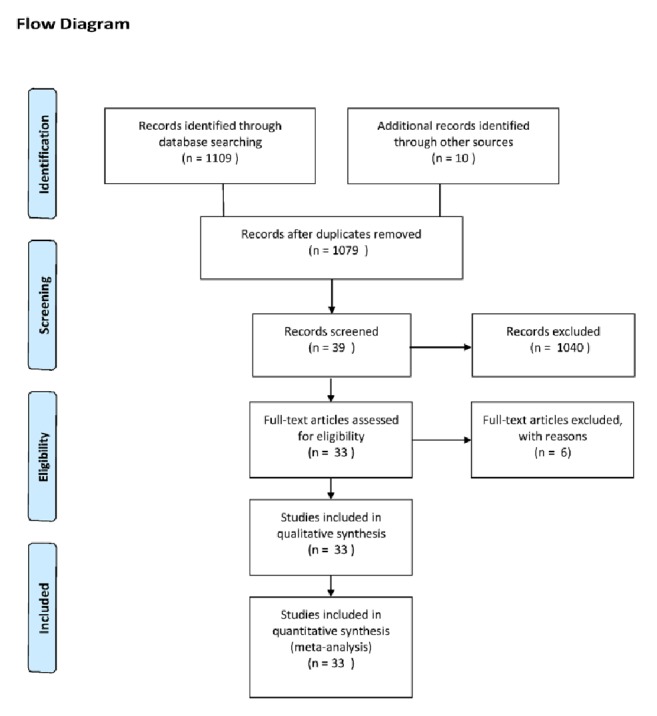
Identification process for eligible trials.
Table 1.
Characteristics of included studies. NS means no available data.
| Publication Date | Author | Experiment group (n) | Control group (n) | Treatments versus Control | Age of experiment group | Age of control | Diagnosis | Diagnosis criteria | Experiment Events | Control Events | Treatment Duration | Jadad | Gender | Nation | Side Effect€ | Side Effect © | Assessment tool |
|---|---|---|---|---|---|---|---|---|---|---|---|---|---|---|---|---|---|
| 2015 | LI Xueqing | 30 | 30 | NS/pinaverium bromide 50mg tid | 46±16 | 44±16 | IBS-D | ROME III | 28 | 24 | 8 weeks | 2 | Mixed | China | 0 | 0 | symptom assessment tool (China) (4 points) |
| 2014 | Zhan Daowei | 29 | 28 | (LR3, ST36,SP6,ST25, ST37,GV20,EX-HN3)∗/pinaverium bromide 50mg tid | 42±14 | 37±13 | IBS-D | ROME III | 26 | 19 | 4 weeks | 3 | Mixed | China | 0 | 0 | symptom assessment tool (China) (4 points) |
| 2014 | Kong Suping | 29 | 28 | (GV20,CV12, ST25, ST36, SP9, ST39)∗/pinaverium bromide 50mg tid | 38±11 | 38±11 | IBS-D | ROME III | 26 | 23 | 4 weeks | 3 | Mixed | China | 0 | 0 | symptom assessment tool (China) (4 points) |
| 2014 | Liu Shuying | 30 | 30 | (GV20,EX-HN3,CV12,ST25,ST37,ST39)∗/pinaverium bromide 50mg tid | 41.4±11.8 | 41.77±8.99 | IBS-D | ROME III | 27 | 23 | 4 weeks | 1 | Mixed | China | 0 | 0 | symptom assessment tool (China) (4 points) |
| 2013 | Wu Yuanjian | 30 | 30 | (ST25, ST36, ST37, SP6, CV8)∗/pinaverium bromide 50mg tid | 37.9±10.2 | 39.8±11.2 | IBS-D | ROME III | 26 | 24 | 4 weeks | 1 | Mixed | China | 0 | 0 | symptom assessment tool (China) (4 points) |
| 2012 | Pei Lixia | 30 | 30 | (ST25, ST36, ST37, SP6, LR3, GV20, EX-HN3)∗/pinaverium bromide 50mg tid | 40.9±10.6 | 37.93±11.45 | IBS-D | ROME III | 27 | 24 | 4 weeks | 3 | Mixed | China | 0 | 0 | symptom assessment tool (China) (4 points) |
| 2013 | LI HAO | 35 | 35 | (ST 25, ST 36, ST37, SP6, LR3, GV20, GV29)∗/pinaverium bromide 50mg tid | 37.9±11.5 | 39.1±11.8 | IBS-D | ROME III | 33 | 27 | 4 weeks | 5 | Mixed | China | 0 | 0 | symptom assessment tool (China) (4 points) |
| 2011 | Sun | 30 | 30 | (ST 25, ST 36, SP6,LR3,DU20,EX-HN 3 and ST 37)∗/pinaverium bromide (50mg tid) | 38.81±11.8 | 38.59±11.45 | IBS-D | ROME III | 27 | 24 | 4 weeks | 3 | Mixed | China | 0 | 0 | symptom assessment tool (China) (4 points) |
| 2010 | Shi | 32 | 38 | (ST 25, ST 36, BL 20, BL 21, BL 23, BL 25 and ST 37)∗/pinaverium bromide (50mg tid) | 38.51±14.65 | 38.68±15.72 | IBS-D | ROME III | 26 | 20 | 4 weeks | 6 | Mixed | China | 0 | 0 | Overall IBS symptom VAS score (10 points) |
| 2017 | Lembo (1) | 426 | 427 | Eluxadoline 100mg /placebo BID | 44.4±13.9 | 45.8±14.1 | IBS-D | ROME III | 107 | 73 | 12 weeks | 7 | Mixed | United States | 500/859 | 450/808 | IBS-D global symptom score, Bristol Stool Form Scale |
| 2017 | Lembo (2) | 383 | 382 | Eluxadoline 100mg /placebo BID | 45.7±13.3 | 47.1±13.8 | IBS-D | ROME III | 113 | 62 | 12 weeks | 7 | Mixed | United States | NS | NS | IBS-D global symptom score, Bristol Stool Form Scale |
| 2013 | DOVE | 163 | 159 | Eluxadoline 100mg /placebo BID | 43.6±10.9 | 44.6±12.5 | IBS-D | ROME III | 46 | 22 | 12 weeks | 7 | Mixed | United States | 73/165 | 78/159 | IBS Global Symptom score, IBS-SSS |
| 2015 | Liang Zheng | 218 | 209 | Pinaverium 50mg tid/placebo | 36.9±11.8 | 36.6±12.6 | IBS | ROME III | 131 | 71 | 4 weeks | 7 | Mixed | China | 40/218 | 32/209 | Bowel Symptom Scale (10 points), Bristol stool form scale |
| 1977 | Levy | 30 | 30 | Pinaverium 50mg tid/placebo | NS | NS | IBS | Clinical | 24 | 17 | 2 weeks | 3 | Mixed | French | NS | NS | NS |
| 1981 | Delmont | 25 | 25 | Pinaverium 50mg tid/placebo | NS | NS | IBS | Clinical | 19 | 17 | 4 weeks | 4 | Mixed | French | NS | NS | NS |
| 2005 | Lin Chang | 131 | 128 | Alosetron 1mg/Vitamin C BID | 44±12 | 43±12 | IBS-D | ROME I | 69 | 51 | 12 weeks | 7 | Mixed | United States | 86/130 | 65/128 | Average abdominal pain and stool consistency score (5 points) |
| 2004 | William D.Chey | 279 | 290 | Alosetron 1mg/Vitamin C BID | 46.2±13.5 | 46.9±12.9 | IBS-D | Clinical | 144 | 119 | 48 weeks | 7 | Women | United States | 297/348 | 261/362 | Average abdominal pain and stool consistency score (5 points) |
| 2004 | Lembo (1) | 147 | 135 | Alosetron 2mg/Vitamin C BID | 48.9±15.5 | 49.4±13.8 | IBS-D | Rome II | 100 | 62 | 12 weeks | 6 | Female | United States | 145/246 | 127/246 | IBS-D global symptom score, Average stool consistency scores (5 points) |
| 2004 | Lembo (2) | 457 | 219 | Alosetron 2mg/Vitamin C BID | 48.8±14.0 | 48.6±13.6 | IBS-D | Rome II | 320 | 99 | 12 weeks | 6 | Female | United States | NS | NS | IBS-D global symptom score, Average stool consistency scores (5 points) |
| 2007 | Krause | 177 | 176 | Alosetron 1mg/Vitamin C BID | 43 | 43 | IBS-D | ROME II | 76 | 54 | 12 weeks | 7 | Women | United States | 102/176 | 94/176 | IBS-D global symptom score, Average stool consistency scores (5 points) |
| 2011 | Lee KJ | 175 | 168 | Ramosetron 5ug Qd/Placebo | 43.4±12.1 | 45±13.1 | IBS-D | Rome III | 65 | 64 | 4 weeks | 3 | Male | Korea | 69/147 | 77/149 | IBS symptoms (5 points), Bristol Stool Form Scale |
| 2008 | Matsueda (1) | 297 | 104 | Ramosetron 1ug Qd, 5ug Qd, 10ug Qd/Placebo | 40.3±11.8 | 38.4±9.56 | IBS-D | Rome II | 110 | 28 | 12 weeks | 6 | Mixed | Japan | 177/309 | 61/108 | IBS symptoms (5 points), Bristol Stool Form Scale |
| 2015 | Fukudo S AB | 307 | 102 | Ramosetron 1.25ug Qd, 2.5ug Qd, 5ug Qd/placebo | 40.9±10.6 | 40.2±10.1 | IBS-D | Rome III | 121 | 29 | 12 weeks | 3 | Female | Japan | NS | NS | IBS symptoms (5 points), Bristol Stool Form Scale |
| 2016 | Fukudo S | 292 | 284 | Ramosetron 2.5ug Qd/Placebo | 41.4±11.8 | 41.5±12.0 | IBS-D | Rome III | 148 | 91 | 12 weeks | 7 | Female | Japan | 154/292 | 118/284 | IBS symptoms (5 points), Bristol Stool Form Scale |
| 2008 | Matsueda (2) | 263 | 265 | Ramosetron 5ug Qd/Placebo | 40.7±11.21 | 41.8±11.70 | IBS-D | Rome II | 124 | 72 | 12 weeks | 5 | Mixed | Japan | 163/270 | 141/269 | IBS symptoms (5 points), Bristol Stool Form Scale |
| 2014 | Fukudo S | 147 | 149 | Ramosetron 5ug Qd/Placebo | 40.9±10.6 | 40.2±10.1 | IBS-D | Rome III | 58 | 26 | 12 weeks | 7 | Male | Japan | 13/175 | 6/168 | IBS symptoms (5 points), Bristol Stool Form Scale |
| 2008 | Lembo | 191 | 197 | Rifaximin 550mg bid/Placebo | NS | NS | IBS-D | Rome II | 100 | 87 | 2 weeks | 4 | Mixed | Multicenter | NS | NS | IBS-D global symptom score, IBS-associated bloating |
| 2011 | Primentel (1) | 309 | 314 | Rifaximin 550mg tid/Placebo | 46.2±15.0 | 45.5±14.6 | Non-C | Rome II | 126 | 98 | 2 weeks | 7 | Mixed | Multicenter | 264/624 | 296/634 | IBS symptoms (5 points), Bristol Stool Form Scale |
| 2011 | Primentel (2) | 315 | 320 | Rifaximin 550mg tid/Placebo | 45.9±13.9 | 46.3±14.6 | Non-C | Rome II | 128 | 103 | 2 weeks | 7 | Mixed | Multicenter | NS | NS | IBS symptoms (5 points), Bristol Stool Form Scale |
| 2017 | Lowe | 43 | 36 | Acupuncture/sham | 42±15 | 43±15 | IBS | Rome I | 23 | 15 | 4 weeks | 7 | Mixed | Canada | 0 | 0 | IBS Symptoms (5 points), SF-36, IBS-36 |
| 2000 | Catherine Lowe | 28 | 22 | Acupuncture/sham | NS | NS | IBS | NS | 16 | 10 | 4 weeks | 3 | Mixed | Canada | NS | NS | NS |
| 2009 | Anthony J | 78 | 77 | Acupuncture/sham | 37.5±14.6 | 38.9±14.1 | IBS | Rome II | 32 | 24 | 3 weeks | 6 | Female | United States | 0 | 0 | IBS-Symptom severity scale, IBS-AR, QOL |
| 2005 | Forbes | 27 | 32 | Acupuncture/sham | 43 | 44.4 | IBS | Rome+Manning | 13 | 10 | 12 weeks | 7 | Mixed | UK | 0 | 0 | global symptom score, Bristol stool scale |
In total, 9712 patients diagnosed with IBS-D/IBS were enrolled in the assessed studies, mean age was between 38 and 46 years, the diagnosis criteria included clinical criteria, ROME I-III, and the treatment duration was from 2 weeks to 48 weeks, mainly between 4 and 12 weeks. The following seven therapeutic methods were included: A: acupuncture; B: eluxadoline; C: pinaverium bromide; D: alosetron; E: ramosetron; F: rifaximin; and G: sham acupuncture; H: placebo (vitamin C, etc.). Documents included 10 articles from China, 9 articles from the United States, 2 papers from France, 2 papers from Canada, 1 paper from United Kingdom, 5 articles from Japan, 1 article from Korea, and 3 articles from multicentre locations. Using the Jadad scale assessment, the overall Jadad score for study quality ranged from 1 to 7, and the median Jadad score was 4 (see Table 1 for details).
3.2. Routine Paired Meta-Analysis
Compared with placebo, acupuncture significantly improved the symptoms of diarrhoea-predominant irritable bowel syndrome (OR: 7.7, 95% CI: 3.8-16.0, I2 = 0%) (Figure 2); compared with placebo, sham acupuncture significantly improved the symptoms of diarrhoea-predominant irritable bowel syndrome (OR:4.7, 95% CI: 2.0 to 11.0); compared with placebo, pinaverium bromide significantly improved the symptoms of diarrhoea-predominant irritable bowel syndrome (OR: 2.6, 95% CI: 1.5 to 4.1, I2 = 0%) (Figure 2); eluxadoline significantly improved the symptoms of diarrhoea-predominant irritable bowel syndrome compared with placebo (OR: 2.0, 95% CI: 1.4-2.8, I2 = 5.3%) (Figure 2); compared with placebo, alosetron also improved the symptoms of diarrhoea-predominant irritable bowel syndrome (OR: 2.0, 95% CI: 1.5-2.6, I2 = 53.3%); compared with placebo, ramosetron also improved the symptoms of diarrhoea-predominant irritable bowel syndrome (OR: 1.9, 95% CI: 1.5-2.4, I2 = 68.1%); and compared with placebo, rifaximin treatment improved the symptoms of diarrhoea-predominant irritable bowel syndrome (OR: 1.5, 95% CI: 1.0-2.0, I2 = 0%) (Figure 2). The efficacy of drugs compared with acupuncture and sham acupuncture was poor (Figure 2).
Figure 2.
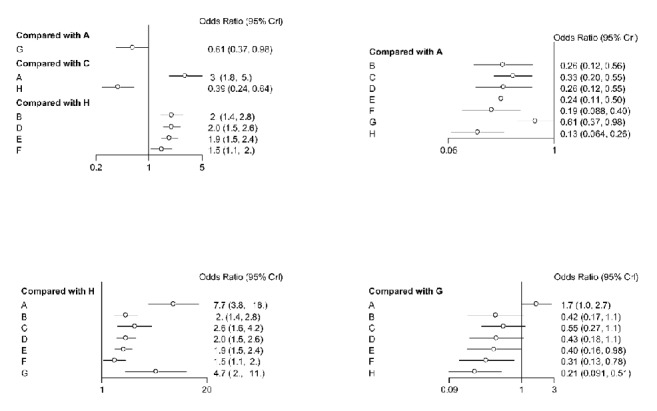
The Forest plot of IBS-D treatment of acupuncture compared with other drugs. A: acupuncture; B: eluxadoline; C: pinaverium bromide; D: alosetron E: ramosetron; F: rifaximin; G: sham acupuncture; H: placebo.
3.3. The Cumulative Probability Ranking
The cumulative probability ranking of the results for diarrhoea-predominant irritable bowel syndrome patients is as follows: acupuncture, sham acupuncture, pinaverium, alosetron = eluxadoline, ramosetron, and rifaximin. The probability distribution rankings of eluxadoline were equal, so we chose the probability of the closest top rank as its ranking result. The efficacy of acupuncture was much higher than that of other drugs (P = 0.977), while sham acupuncture had a higher drug efficacy (P = 0.90) than pinaverium bromide (P=0.69), alosetron (P = 0.35), eluxadoline (P= 0.30), ramosetron (P=0.31), and rifaximin (P=0.81) (Figure 3, Table 2).
Figure 3.
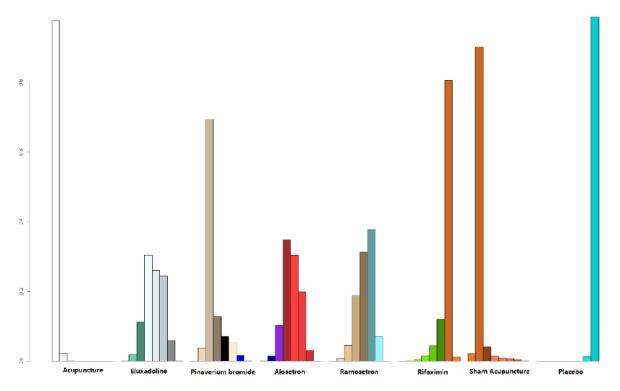
The cumulative probability ranking plot of treatment effect of acupuncture and other drugs on IBS-D.
Table 2.
The cumulative probability rankings of treatment effect of acupuncture on IBS-D.
| Methods/Rankings | 1 | 2 | 3 | 4 | 5 | 6 | 7 | 8 |
|---|---|---|---|---|---|---|---|---|
| Acupuncture | 9.774500e-01 | 0.0221666667 | 0.0003166667 | 6.666667e-05 | 0.000000000 | 0.0000000000 | 0.000000000 | 0.000000e+00 |
| Eluxadoline | 7.000000e-04 | 0.0183166667 | 0.1130666667 | 3.042167e-01 | 0.260266667 | 0.2448666667 | 0.058383333 | 1.833333e-04 |
| Pinaverium Bromide | 0.000000e+00 | 0.0371500000 | 0.6937166667 | 1.282833e-01 | 0.070783333 | 0.0527000000 | 0.016733333 | 6.333333e-04 |
| Alosetron | 4.333333e-04 | 0.0141500000 | 0.1021333333 | 3.490500e-01 | 0.304650000 | 0.1983666667 | 0.031200000 | 1.666667e-05 |
| Ramosetron | 1.333333e-04 | 0.0056333333 | 0.0452000000 | 1.890667e-01 | 0.312650000 | 0.3764000000 | 0.070916667 | 0.000000e+00 |
| Rifaximin | 1.666667e-05 | 0.0005333333 | 0.0039000000 | 1.546667e-02 | 0.042683333 | 0.1198666667 | 0.806500000 | 1.103333e-02 |
| Sham Acupuncture | 2.126667e-02 | 0.9020500000 | 0.0416666667 | 1.385000e-02 | 0.008966667 | 0.0076833333 | 0.003983333 | 5.333333e-04 |
| Placebo | 0.000000e+00 | 0.0000000000 | 0.0000000000 | 0.000000e+00 | 0.000000000 | 0.0001166667 | 0.012283333 | 9.876000e-01 |
There were 22 studies that reported side effect data (Table 1); there were no reported side effects from acupuncture, so acupuncture was not included in the analysis. The rest of the reported side effect data contained all other 6 treatment regimens (Table 3). Because the side effects of acupuncture were 0, its side effects were the lowest, followed by other drugs; the smallest side effects were for eluxadoline (P = 0.39) and pinaverium bromide (P = 0.21), and there were more side effects from rifaximin (P = 0.44) than from other drugs. Ramosetron also showed more side effects than alosetron (Figure 4).
Table 3.
The cumulative probability rankings of side effect of drugs on IBS-D.
| Drugs/Possibility | 1 | 2 | 3 | 4 | 5 | 6 |
|---|---|---|---|---|---|---|
| Eluxadoline | 0.0089250 | 0.0265875 | 0.082650 | 0.1953500 | 0.2967500 | 0.3897375 |
| Pinaverium | 0.1554125 | 0.1458000 | 0.194750 | 0.1840000 | 0.1073250 | 0.2127125 |
| Alosetron | 0.3657750 | 0.4054750 | 0.171675 | 0.0457000 | 0.0092500 | 0.0021250 |
| Ramosetron | 0.0335625 | 0.1281875 | 0.381825 | 0.3390875 | 0.0883750 | 0.0289625 |
| Rifaximin | 0.4363125 | 0.2926750 | 0.149800 | 0.0673875 | 0.0296375 | 0.0241875 |
| Placebo | 0.0000125 | 0.0012750 | 0.019300 | 0.1684750 | 0.4686625 | 0.3422750 |
Figure 4.
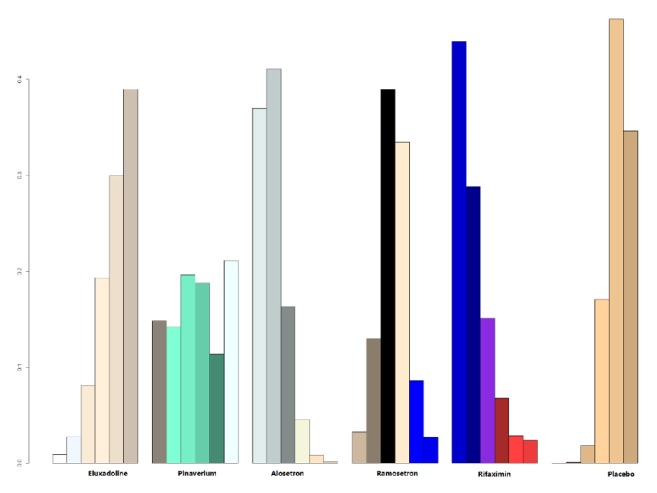
The cumulative probability ranking plot of side effect of drugs on IBS-D.
3.4. Network Plot
We compared all of the included studies and drew network diagrams, with the studies incorporated into quality-based displays on a network map (Figure 5).
Figure 5.
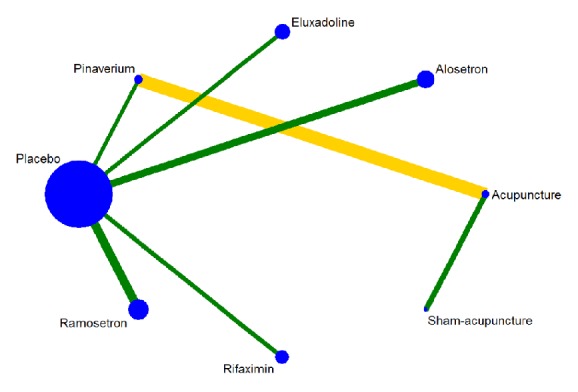
The network plot of all treatment methods: yellow means the low-quality studies, green means the high-quality studies.
3.5. Acupuncture Preference Points
In view of the different acupuncture points selected for each study, we selected the most commonly used acupoints, including ST-25, ST-37, ST-36, SP-6, GV-20, and EX-HN3; the use of these 6 acupoints was 4 times more common than other acupoints (Table 4).
Table 4.
Most commonly used acupoints in our included articles.
| Acupoint Number | Frequency | Positions |
|---|---|---|
| ST-25 | 10 | Abdomen |
| ST-37 | 9 | Leg |
| ST-36 | 8 | Leg |
| SP-6 | 5 | Leg |
| GV20 | 5 | Head |
| EX-HN3 | 4 | Forehead |
3.6. Brooks-Gelman-Rubin Diagnostic Plot, Density Plot, Node-Splitting Plot, and Cumulative Contribution Plot
By performing 20,000 convergence iterations, we obtained a Brooks-Gelman-Rubin diagnostic plot, and the track density map was acceptable; based on the node-splitting model, we found all studies in the region beneath the 4th line. We also obtained a cumulative contribution map from the STATA software (Figures 6, 7, 8, and 9).
Figure 6.
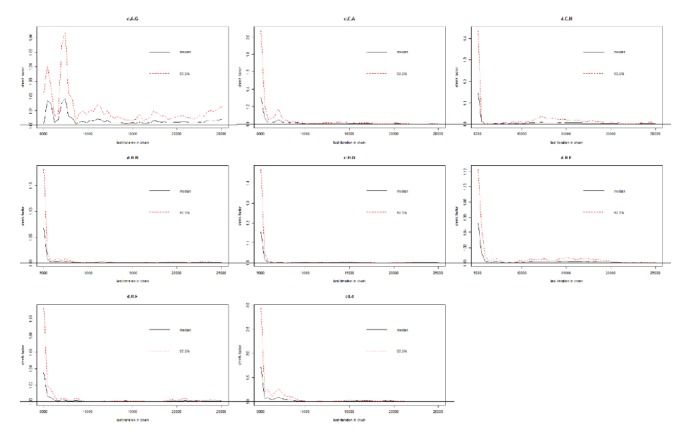
Brooks-Gelman-Rubin diagnostic plot of included studies.
Figure 7.
Density plot of included studies.
Figure 8.
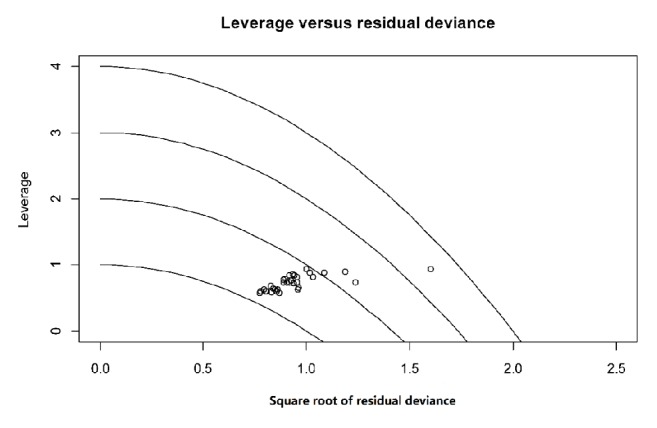
Node-splitting plot of included studies.
Figure 9.
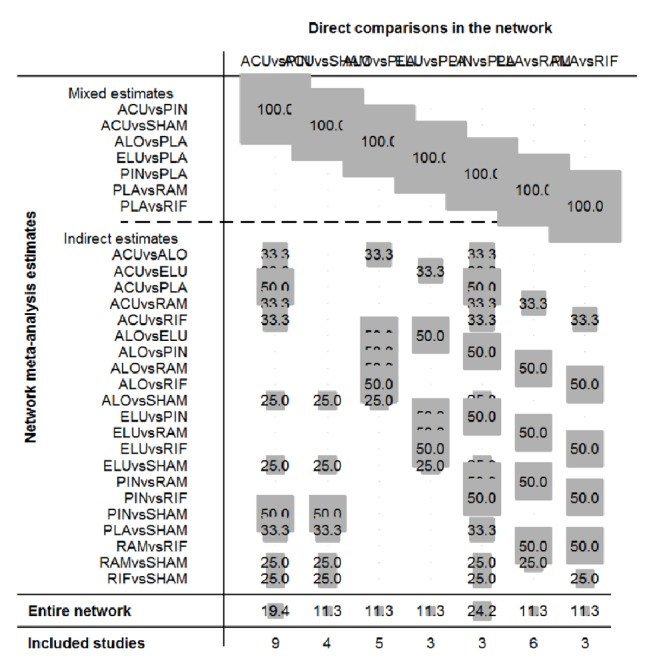
The cumulative contribution plot of IBS-D treatment of acupuncture compared with other drugs. ACU: acupuncture; ELU: eluxadoline; PIN: pinaverium bromide; ALO: alosetron; RAM: ramosetron; RIF: rifaximin; SHAM: sham acupuncture; PLA: placebo.
3.7. Heterogeneity and Sensitivity Analysis
Using heterogeneity analysis, we found that alosetron and ramosetron had significant heterogeneity; based on the sensitivity analysis, we corrected the OR for alosetron (OR: 1.29, 95% CI: 1.17-1.42) and the OR for placebo and ramosetron (OR: 1.33, 95% CI: 1.22-1.39), and no large directional change occurred even after corrections (Figure 10).
Figure 10.
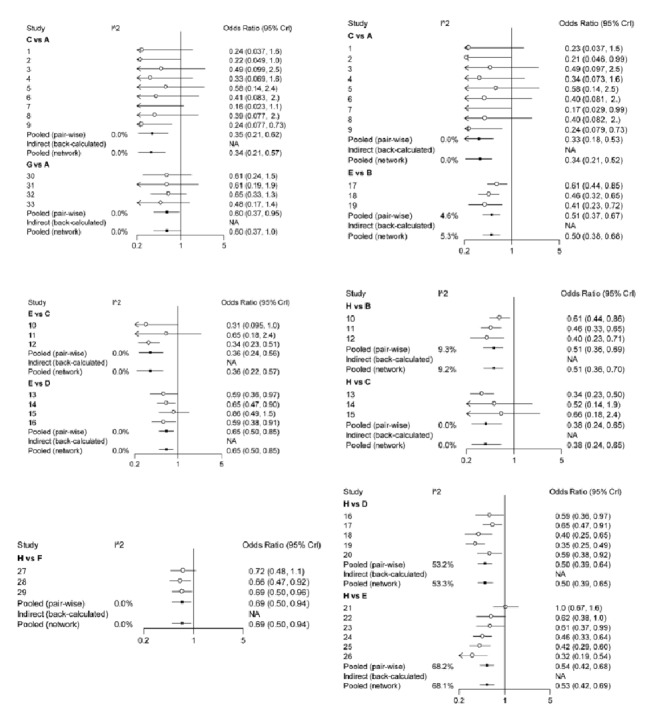
The heterogeneity analysis of included studies. A: acupuncture; B: eluxadoline; C: pinaverium bromide; D: alosetron; E: ramosetron; F: rifaximin; G: sham acupuncture; H: placebo.
3.8. Publication Bias
The funnel plot shows that all included studies were compared on a pairwise basis, and all the studies were found to be essentially symmetrical, indicating a small publication bias (Figure 11).
Figure 11.
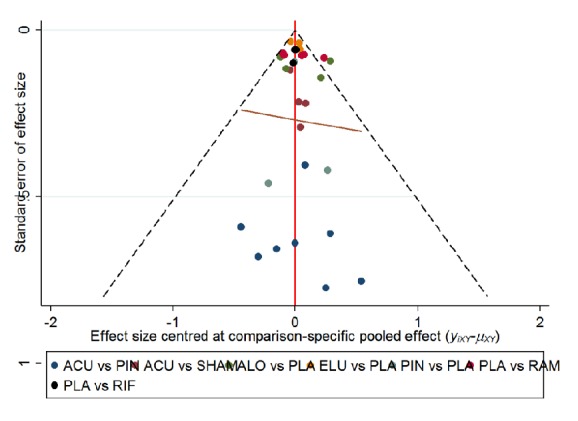
The funnel plot of all included studies. ACU: acupuncture; ELU: eluxadoline; PIN: pinaverium bromide; ALO: alosetron; RAM: ramosetron; RIF: rifaximin; SHAM: sham acupuncture; PLA: placebo.
4. Discussion
Through NMA, this article found that the effect of acupuncture treatment on diarrhoea-predominant irritable bowel syndrome was better than that of the assessed drugs, with close to no side effects. Previous studies have shown that the effects of acupuncture treatment on diarrhoea-predominant irritable bowel syndrome are still not yet clear, but there are several relevant studies to prove its possible role in treatment. Several studies have confirmed the co-occurrence of IBS and the excessive release of proinflammatory cytokines and insufficiencies in anti-inflammatory cytokine secretion [41]. Animal studies have shown that electroacupuncture can significantly reduce the peripheral blood flow of patients with 5-HT positive reactant content and reduce the sensitivity of afferent nerves, thereby reducing visceral hypersensitivity [42]. Studies also indicate that acupuncture can significantly reduce rat colon and dorsal root ganglia 5-HT concentrations [43]. Animal experiments have shown that acupuncture may serve as an effective treatment by regulating the abnormal state of colon mast cells [44]. Previous studies have also shown that acupuncture can reduce the number of mast EA cells in ovalbumin-sensitized mice, increasing visceral sensory thresholds and improving visceral hypersensitivity [45]. In addition, acupuncture can relieve thalamic pain in patients with advanced and central signalling pathways involving 5-HT [46]. At the same time, studies have shown that acupuncture has low side effects, an idea that has reached a certain consensus [47].
However, previous meta-analyses showed no significant benefit of acupuncture compared with sham acupuncture groups in the treatment of IBS. Only a few studies from China have demonstrated the superiority of acupuncture relative to drugs [48]. Other studies have shown that acupuncture is not or only slightly superior to sham acupuncture treatment [37]. However, our study only selected patients with IBS-D, and the effect was more significant; whether acupuncture is better for IBS-D than it is for constipation or mixed IBS remains to be further studied. A large part of this study included post-2012 studies that were inconsistent in the acupoints selected between IBS-D and other types of IBS, and this study generally included the same acupuncture points to ensure consistency in the assessment of fixed acupuncture points; to yield definitive results, sham acupuncture groups should be increased in further studies.
However, in the past, most studies conducted a direct comparison between acupuncture and pinaverium bromide. There is no direct comparison between acupuncture and other drugs such as ramosetron, alosetron, rifaximin, and eluxadoline. In the future, direct comparisons can be used to compare differences in efficacy. At the same time, this article found that the evaluation scale used in acupuncture-related research is different from other drugs (only 4 points), which will lead to a bias in the evaluation to a certain extent. In the meantime, the quantity of previous acupuncture research is relatively low, so the conclusions remain to be confirmed; these findings can be verified by increasing the sample size and using multicentre double-blind randomized controlled studies.
This study also shows sham acupuncture for the treatment of IBS-D was more effective than other drugs. Previously, there was a lack of direct comparison between sham acupuncture and oral placebo drugs, our study provides an indirect result between sham acupuncture and oral drug placebo, and there exists some curative effect for IBS-D. Actually, sham acupuncture uses the blunt needle as control, which is the same as the mechanisms of acupressure, a previous comment showed sham acupuncture may be not a good control for experiment group [49], and our study has proved this point. Now, there are many studies using sham acupuncture as control group; whether the effect of acupuncture was underestimated still needs direct comparison between sham group and oral placebo. In the future, we need to use the drug placebo control group or improve the sham acupuncture method to weaken the curative effect of sham acupuncture.
This study shows that pinaverium bromide for the treatment of IBS-D was more effective and had fewer side effects than other drugs. Previously, there was a lack of NMA comparing pinaverium bromide and other drugs. A meta-analysis of antispasmodics showed that the pinaverium bromide-induced overall improvement in symptoms of irritable bowel syndrome was 1.55 (CI 95%: 1.33-1.83) and that improvement in abdominal pain was 1.52 (CI%: 1.28-1.80) [50], which is consistent with the results obtained in this study. However, a previous study showed that the efficiency of joint pinaverium bromide-venlafaxine sustained-release tablets on IBS-D reached 85.02%, which was higher than that seen when using only pinaverium bromide (64.29%) [51]. All of the drugs compared in this study were single drugs, and this study was unable to verify multiple drug efficacies.
This study shows that alosetron has better efficacy than ramosetron, but with many side effects. Previous studies have shown the occurrence of side effects from alosetron in the treatment of IBS-D (RR = 1.16, 95% CI: 1.08, 1.25) [52], which is consistent with the results of this study. However, most patients included in our study were female patients with severe IBS-D. Alosetron is not used in the treatment of typical IBS-D patients, but for female patients with severe IBS-D, alosetron may be a good choice.
The most frequently used acupuncture points for IBS-D were ST-25, ST-37, ST-36, SP-6, GV-20, and EX-HN3. Studies have reported that the electrical stimulation of rat hind limbs at ST-36 bits can significantly improve colonic hypersensitivity [53]. Research has shown that using electroacupuncture at the ST25 stimulation site can regulate the brain glucose metabolism rates and improve visceral hypersensitivity [54]. Studies have shown that ST25 and ST37 are able to increase the pain threshold in rats with chronic visceral hypersensitivity by reducing 5-HT concentration and increasing 5-HT4R concentration [42]. Doctors choose the patient's acupuncture points based on self-judgement, preferences, and experience. It was very difficult to find consistency in previous studies, which made it difficult to achieve a consistent comparison of results because different acupoints were used. Consistent acupoint studies conducted in the future may be helpful in research or clinical applications.
This study has several advantages and disadvantages. Limitations include the poor quality of some of our studies, the relatively small number of people included, and the fact that some of the studied populations were regional. At the same time, some studies lacked safety records and some results lacked age records, which could have an impact on the results. Meanwhile, the outcome evaluation index used in this study was an overall symptom improvement scale. The drugs used in this study were single drugs. The lack of a combination effect between drugs will have a certain difference from clinical applications.
In summary, this study found that acupuncture may be a good treatment for IBS-D with few side effects, but more research is needed in the future to prove this. Sham acupuncture may be not a good control because of its curative effect for IBS-D. Pinaverium bromide is also a treatment option, as it showed a curative effect with fewer side effects.
Conflicts of Interest
The authors declare that they have no conflicts of interest.
Authors' Contributions
Lingping Zhu was responsible for the design of this study. Lingping Zhu and Shasha Ye performed the search of related articles. Yunhui Ma and Zhiqun Shu performed the extraction of data. Lingping Zhu and Yunhui Ma performed the statistical analysis. Lingping Zhu performed the manuscript editing.
Supplementary Materials
Supplementary 1. Detailed searching strategy.
References
- 1.Lovell R. M., Ford A. C. Effect of gender on prevalence of irritable bowel syndrome in the community: systematic review and meta-analysis. American Journal of Gastroenterology. 2012;107(7):991–1000. doi: 10.1038/ajg.2012.131. [DOI] [PubMed] [Google Scholar]
- 2.Oshima T., Miwa H. Epidemiology of functional gastrointestinal disorders in Japan and in the world. Journal of Neurogastroenterology and Motility. 2015;21(3):320–329. doi: 10.5056/jnm14165. [DOI] [PMC free article] [PubMed] [Google Scholar]
- 3.Andrae D. A., Patrick D. L., Drossman D. A., Covington P. S. Evaluation of the Irritable Bowel Syndrome Quality of Life (IBS-QOL) questionnaire in diarrheal-predominant irritable bowel syndrome patients. Health and Quality of Life Outcomes. 2013;11, article 208 doi: 10.1186/1477-7525-11-208. [DOI] [PMC free article] [PubMed] [Google Scholar]
- 4.Deiteren A., de Wit A., van der Linden L., de Man J. G., Pelckmans P. A., de Winter B. Y. Irritable bowel syndrome and visceral hypersensitivity: Risk factors and patho-physiological mechanisms. Acta Gastro-Enterologica Belgica. 2016;79(1):29–38. [PubMed] [Google Scholar]
- 5.Chey W. D., Kurlander J., Eswaran S. Irritable bowel syndrome: a clinical review. The Journal of the American Medical Association. 2015;313(9):949–958. doi: 10.1001/jama.2015.0954. [DOI] [PubMed] [Google Scholar]
- 6.Hutton B., Salanti G., Caldwell D. M., et al. The PRISMA extension statement for reporting of systematic reviews incorporating network meta-analyses of health care interventions: Checklist and explanations. Annals of Internal Medicine. 2015;162(11):777–784. doi: 10.7326/M14-2385. [DOI] [PubMed] [Google Scholar]
- 7.Liberati A., Altman D. G., Tetzlaff J., et al. The PRISMA statement for reporting systematic reviews and meta-analyses of studies that evaluate health care interventions: explanation and elaboration. PLoS Medicine. 2009;6(7) doi: 10.1371/journal.pmed.1000100.e1000100 [DOI] [PMC free article] [PubMed] [Google Scholar]
- 8.Jadad A. R., Moore R. A., Carroll D., et al. Assessing the quality of reports of randomized clinical trials: Is blinding necessary? Controlled Clinical Trials. 1996;17(1):1–12. doi: 10.1016/0197-2456(95)00134-4. [DOI] [PubMed] [Google Scholar]
- 9.Warn D. E., Thompson S. G., Spiegelhalter D. J. Bayesian random effects meta-analysis of trials with binary outcomes: Methods for the absolute risk difference and relative risk scales. Statistics in Medicine. 2002;21(11):1601–1623. doi: 10.1002/sim.1189. [DOI] [PubMed] [Google Scholar]
- 10.Lunn D. J., Thomas A., Best N., Spiegelhalter D. WinBUGS - A Bayesian modelling framework: Concepts, structure, and extensibility. Statistics and Computing. 2000;10(4):325–337. doi: 10.1023/A:1008929526011. [DOI] [Google Scholar]
- 11.Levy C., Charbonnier A., Cachin M. Sem Hop Ther. Vol. 53. 53: 372; 1977. Pinaverium bromide bromide and functional colonic disease double-blind study; p. p. 374. [PubMed] [Google Scholar]
- 12.Xueqing L., Shiying M., Xin L. Therapeutic Observation of Diarrhea-predominant Irritable Bowel Syndrome Majorly Treated by Acupuncture with Ling Gui Ba Fa. Shanghai Journal of Acupuncture and Moxibustion. 2015;34(1):22–24. [Google Scholar]
- 13.Daowei Z., Jianhua S., Kaitao L., Luzhou X., Junling Z., Lixia P. Effects and efficacy observation of acupuncture on serum 5-HT in patients with diarrhea-predominant irritable bowel syndrome. Chinese Acupuncture and Moxibustion. 2014;34(2) [PubMed] [Google Scholar]
- 14.Su-ping K., Wen-qin W., Ning X., Qiwen T. Clinical Research of Acupuncture plus Ginger-partitioned Moxibustion for Diarrhea-predominant Irritable Bowel Syndrome. Shanghai Journal of Acupuncture and Moxibustion. 2014;33(10):895–898. doi: 10.1007/s11726-014-0806-6. [DOI] [Google Scholar]
- 15.Shu-ying L. “Tiao Shen Jian pi” acupuncture treatment of diarrhea-predominant irritable bowel syndrome. Guangxi Journal of Traditional Chinese Medicine. 2014;37(4):55–57. [Google Scholar]
- 16.Yuan-jian W., Jie G. 30 cases of Acupuncture treatment of diarrhea-predominant irritable bowel syndromef. Journal of External Therapy of Traditional Chinese Medicine. 2013;22(5):38–39. [Google Scholar]
- 17.Li-xia P., Jian-hua S., Chen X., et al. Clinical Evaluation of Acupuncture Treating IBS-D Belonging to Liver Depression and Spleen Deficiency Syndrome. Journal of Nanjing University of Traditional Chinese Medicine. 2012;28(1):p. 601. doi: 10.1007/s11655-011-0875-z. [DOI] [Google Scholar]
- 18.Li H., Lx P., Jl Z., Jian-hua S. Controlled observation on the efficacy of acupuncture and western medicine on diarrhea-type irritable bowel syndrome. World Journal of Acupuncture-Moxibuation. 2013;23(2):11–16. doi: 10.1016/S1003-5257(13)60037-9. [DOI] [Google Scholar]
- 19.Sun J.-H., Wu X.-L., Xia C., et al. Clinical evaluation of Soothing Gan and invigorating Pi acupuncture treatment on diarrhea-predominant irritable bowel syndrome. Chinese Journal of Integrative Medicine. 2011;17(10):780–785. doi: 10.1007/s11655-011-0875-z. [DOI] [PubMed] [Google Scholar]
- 20.Shi X., Luo J., Tan T. Clinical observation of electroacupuncture on diarrhea-predominant irritable bowel syndrome. Journal of New Chinese Medicine. 2010;42(5):72–74. [Google Scholar]
- 21.Lembo A. J., Lacy B. E., Zuckerman M. J., et al. Eluxadoline for Irritable Bowel Syndrome with Diarrhea. The New England Journal of Medicine. 2016;374(3):242–253. doi: 10.1056/NEJMoa1505180. [DOI] [PubMed] [Google Scholar]
- 22.Dove L. S., Lembo A., Randall C. W., et al. Eluxadoline Benefits Patients with Irritable Bowel Syndrome with Diarrhea in a Phase 2 Study. Gastroenterology. 2013;145(2):329–338. doi: 10.1053/j.gastro.2013.04.006. [DOI] [PubMed] [Google Scholar]
- 23.Zheng L., Lai Y., Lu W., Li B., Fan H., Yan Z. Pinaverium Reduces Symptoms of Irritable Bowel Syndrome in a Multicenter, Randomized, Controlled Trial. Clinical Gastroenterology & Hepatology. 2015;3(7):p. 1285. doi: 10.1016/j.cgh.2015.01.015. [DOI] [PubMed] [Google Scholar]
- 24.Delmont J. The value of adding an antispasmodic musculotropic agent in the treatment of painful constipation in functional colopathies with bran. Double-blind study. Med Chir Dig. 1981;10:365–370. [PubMed] [Google Scholar]
- 25.Chang L., Ameen V. Z., Dukes G. E., McSorley D. J., Carter E. G., Mayer E. A. A dose-ranging, phase II study of the efficacy and safety of alosetron in men with diarrhea-predominant IBS. American Journal of Gastroenterology. 2005;100(1):115–123. doi: 10.1111/j.1572-0241.2005.40365.x. [DOI] [PubMed] [Google Scholar]
- 26.Chey W. D., Chey W. Y., Heath A. T., et al. Long-term safety and efficacy of alosetron in women with severe diarrhea-predominant irritable bowel syndrome. American Journal of Gastroenterology. 2004;99(11):2195–2203. doi: 10.1111/j.1572-0241.2004.30509.x. [DOI] [PubMed] [Google Scholar]
- 27.Lembo A. J., Olden K. W., Ameen V. Z., Gordon S. L., Heath A. T., Carter E. G. Effect of alosetron on bowel urgency and global symptoms in women with severe, diarrhea-predominant irritable bowel syndrome: Analysis of two controlled trials. Clinical Gastroenterology and Hepatology. 2004;2(8):675–682. doi: 10.1016/S1542-3565(04)00284-8. [DOI] [PubMed] [Google Scholar]
- 28.Krause R., Ameen V., Gordon S. H., et al. A randomized, double-blind, placebo-controlled study to assess efficacy and safety of 0.5 mg and 1 mg alosetron in women with severe diarrhea-predominant IBS. American Journal of Gastroenterology. 2007;102(8):1709–1719. doi: 10.1111/j.1572-0241.2007.01282.x. [DOI] [PubMed] [Google Scholar]
- 29.Lee K. J., Kim N. Y., Kwon J. K., et al. Efficacy of ramosetron in the treatment of male patients with irritable bowel syndrome with diarrhea: A multicenter, randomized clinical trial, compared with mebeverine. Neurogastroenterology & Motility. 2011;23(12):1098–1104. doi: 10.1111/j.1365-2982.2011.01771.x. [DOI] [PubMed] [Google Scholar]
- 30.Matsueda K., Harasawa S., Hongo M., Hiwatashi N., Sasaki D. A phase II trial of the novel serotonin type 3 receptor antagonist ramosetron in Japanese male and female patients with diarrhea-predominant irritable bowel syndrome. Digestion. 2008;77(3-4):225–235. doi: 10.1159/000150632. [DOI] [PubMed] [Google Scholar]
- 31.Fukudo S., Matsueda K., Haruma K., et al. Mo1281 Optimal Dose of Ramosetron in Female Patients With Irritable Bowel Syndrome With Diarrhea: A Randomized, Placebo-Controlled Phase II Trial. Gastroenterology. 2015;148(4):p. S-659. doi: 10.1016/S0016-5085(15)32226-5. [DOI] [Google Scholar]
- 32.Fukudo S., Kinoshita Y., Okumura T., et al. Effect of ramosetron in female patients with irritable bowel syndrome with diarrhea: a phase III long-term study. Journal of Gastroenterology. 2016;51(9):874–882. doi: 10.1007/s00535-016-1165-5. [DOI] [PubMed] [Google Scholar]
- 33.Matsueda K., Harasawa S., Hongo M., Hiwatashi N., Sasaki D. A randomized, double-blind, placebo-controlled clinical trial of the effectiveness of the novel serotonin type 3 receptor antagonist ramosetron in both male and female Japanese patients with diarrhea-predominant irritable bowel syndrome. Scandinavian Journal of Gastroenterology. 2008;43(10):1202–1211. doi: 10.1080/00365520802240255. [DOI] [PubMed] [Google Scholar]
- 34.Fukudo S., Ida M., Akiho H., Nakashima Y., Matsueda K. Effect of Ramosetron on Stool Consistency in Male Patients With Irritable Bowel Syndrome With Diarrhea. Clinical Gastroenterology and Hepatology. 2014;12(6):953–954. doi: 10.1016/j.cgh.2013.11.024. [DOI] [PubMed] [Google Scholar]
- 35.Lembo A., Zakko S. F., Ferreira N. L., et al. T1390 Rifaximin for the Treatment of Diarrhea-Associated Irritable Bowel Syndrome: Short Term Treatment Leading to Long Term Sustained Response. Gastroenterology. 2008;134(4):p. A-545. doi: 10.1016/S0016-5085(08)62544-5. [DOI] [Google Scholar]
- 36.Pimentel M., Lembo A., Chey W. D., et al. Rifaximin therapy for patients with irritable bowel syndrome without constipation. The New England Journal of Medicine. 2011;364(1):22–32. doi: 10.1056/nejmoa1004409. [DOI] [PubMed] [Google Scholar]
- 37.Lowe C., Aiken A., Day A. G., Depew W., Vanner S. J. Sham acupuncture is as efficacious as true acupuncture for the treatment of IBS: A randomized placebo controlled trial. Neurogastroenterology & Motility. 2017;29(7) doi: 10.1111/nmo.13040.e13040 [DOI] [PubMed] [Google Scholar]
- 38.Lowe C., Depew W. T., Vanner S. J. A placebo-controlled, double-blind trial of acupuncture in the treatment of irritable bowel syndrome (IBS) Gastroenterology. 2000;118(4):p. A617. doi: 10.1016/S0016-5085(00)84606-5. [DOI] [Google Scholar]
- 39.Lembo A. J., Conboy L., Kelley J. M., et al. A treatment trial of acupuncture in IBS patients. American Journal of Gastroenterology. 2009;104(6):1489–1497. doi: 10.1038/ajg.2009.156. [DOI] [PMC free article] [PubMed] [Google Scholar]
- 40.Forbes A., Jackson S., Walter C., Quraishi S., Jacyna M., Pitcher M. Acupuncture for irritable bowel syndrome: a blinded placebo-controlled trial. World Journal of Gastroenterology. 2005;11(26):4040–4044. doi: 10.3748/wjg.v11.i26.4040. [DOI] [PMC free article] [PubMed] [Google Scholar]
- 41.Chiba T., Sato K., Toya Y., et al. Serial changes in cytokine expression in irritable bowel syndrome patients following treatment with calcium polycarbophil. Hepato-Gastroenterology. 2011;58(110-111):1527–1530. doi: 10.5754/hge10503. [DOI] [PubMed] [Google Scholar]
- 42.Liu H.-R., Wang X.-M., Zhou E.-H., et al. Acupuncture at both ST25 and ST37 improves the pain threshold of chronic visceral hypersensitivity rats. Neurochemical Research. 2009;34(11):1914–1918. doi: 10.1007/s11064-009-9972-1. [DOI] [PubMed] [Google Scholar]
- 43.Sun J.-H., Wu X.-L., Meng Y.-F., et al. Electro-acupuncture decreases 5-HT, CGRP and increases NPY in the brain-gut axis in two rat models of Diarrhea-predominant irritable bowel syndrome(D-IBS) BMC Complementary and Alternative Medicine. 2015;15, article 340 doi: 10.1186/s12906-015-0863-5. [DOI] [PMC free article] [PubMed] [Google Scholar]
- 44.Wu H.-G., Jiang B., Zhou E.-H., et al. Regulatory mechanism of electroacupuncture in irritable bowel syndrome: preventing MC activation and decreasing SP VIP secretion. Digestive Diseases and Sciences. 2008;53(6):1644–1651. doi: 10.1007/s10620-007-0062-4. [DOI] [PubMed] [Google Scholar]
- 45.Ma X. P., Tan L. Y., Yang Y., et al. Effect of electro-acupuncture on substance p, its receptor and corticotropin-releasing hormone in rats with irritable bowel syndrome. World J Gastroenterol. 2009;15(41):5211–5217. doi: 10.3748/wjg.15.5211. [DOI] [PMC free article] [PubMed] [Google Scholar]
- 46.Chu W. C. W., Wu J. C. Y., Yew D. T. W., et al. Does acupuncture therapy alter activation of neural pathway for pain perception in irritable bowel syndrome?: a comparative study of true and sham acupuncture using functional magnetic resonance imaging. Journal of Neurogastroenterology and Motility. 2012;18(3):305–316. doi: 10.5056/jnm.2012.18.3.305. [DOI] [PMC free article] [PubMed] [Google Scholar]
- 47. https://consensus.nih.gov/1997/1997Acupuncture107pdf.pdf.
- 48.Manheimer E., Wieland L. S., Cheng K., et al. Acupuncture for irritable bowel syndrome: systematic review and meta-analysis. American Journal of Gastroenterology. 2012;107(6):835–847. doi: 10.1038/ajg.2012.66. [DOI] [PMC free article] [PubMed] [Google Scholar]
- 49.Lundeberg T., Lund I., Sing A., Näslund J. Is placebo acupuncture what it is intended to be? Evidence-Based Complementray and Alternative Medicine. 2011;2011 doi: 10.1093/ecam/nep049.932407 [DOI] [PMC free article] [PubMed] [Google Scholar]
- 50.Martínez-Vázquez M. A., Vázquez-Elizondo G., González-González J. A., Gutiérrez-Udave R., Maldonado-Garza H. J., Bosques-Padilla F. J. Effect of antispasmodic agents, alone or in combination, in the treatment of Irritable Bowel Syndrome: systematic review and meta-analysis. Revista de Gastroenterología de México. 2012;77(2):82–90. doi: 10.1016/j.rgmx.2012.04.002. [DOI] [PubMed] [Google Scholar]
- 51.The clinical Research Group of Venlafaxine to Treat Irritable Bowel Syndrome. Randomized, parallel-control and multi-centered research on venlafaxine sustained release table and pinaverium bromide treating patients with diarrhea-predominant irritable bowel syndrome. Chinese Journal of Digestion. 2013;33(5):307–311. [Google Scholar]
- 52.Zheng Y., Yu T., Tang Y., Xiong W., Shen X., Jiang L. Efficacy and safety of 5-hydroxytryptamine 3 receptor antagonists in irritable bowel syndrome: a systematic review and meta-analysis of randomized controlled trials. Plos One. 2017;12(3) doi: 10.1371/journal.pone.0172846.e0172846 [DOI] [PMC free article] [PubMed] [Google Scholar]
- 53.Zhu W. L., Ying L. I., Zhang L. F., Zhu J., Yang J. M., Shen X. Y. Different effects in ibs model rats by electro-acupuncture of zusanli(st36) and tianshu(st25) on stomach meridian. Journal of Traditional Chinese Medicine & Pharmacy. 2014;29(3):736–738. [Google Scholar]
- 54.Zuo C. T., Wang X. L., Guan Y. H., Wu H. J. Study of brain fdg-pet mapping in patients with d-ibs treated by electrical acupuncture on st25. Society of Nuclear Medicine Annual Meeting Abstracts [Google Scholar]
Associated Data
This section collects any data citations, data availability statements, or supplementary materials included in this article.
Supplementary Materials
Supplementary 1. Detailed searching strategy.



